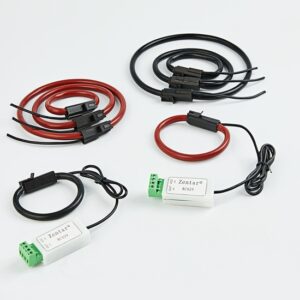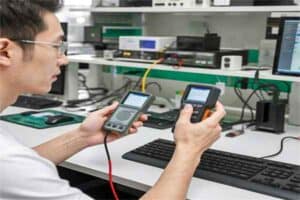Transformers exist in two forms in the industrial field, that is current transformer and voltage or potential transformers, and their main role are for the measurement or protection, and automatic control, etc. They are windly used in the power grid of the network reconstruction projects. In general, most of the occasions of using electricity will use the transformer.
Voltage or Potential transformer

Voltage transformers and current transformers are similar. The characteristics of the voltage transformer are:
(1) The volume is not very large, just like a small volume transformer.
(2) The secondary side load is relatively stable, and the characteristic impedance of the voltage electromagnetic coil of the connected accurate detection instrument and the relay is very high, so when it is running normally, the voltage transformer is close to no load.
(3) The ratio of the rated voltage and current of the primary and secondary electromagnetic coils of the voltage transformer is called the ratio of the rated voltage and current of the voltage transformer. That is: kn=U1n/U2n.
Current transformer

1.Current transformer is a kind of electrical current conversion mechanical equipment. It converts high-voltage and low-voltage large currents into small currents with lower working voltage requirements, and provides them to instrument panels and relay protection devices, machinery and equipment, and separates them from the high-voltage power supply circuit.
2. The secondary side current of the current transformer is 5A or 1A, most of current transformer Xiamen ZTC Technology make are even lower to mA. which will make the application of accurate detection instruments and relay protection devices safer and more convenient, and can also make it standardized in the production and manufacturing.
3. The secondary circuit of the current transformer is also not allowed to indicate the direction. In the working process of the current transformer, its secondary circuit is closed from beginning to end. However, the characteristic impedance of the winding resistance between the precise detection instrument and the protection mechanical device is very small.
4. The working condition is close to the short-circuit fault condition. Most of the magnetizing force formed by the primary current is filled by the secondary current. The total magnetic flux density is not very large, and the potential difference of the secondary winding is not very large. When the current transformer indicates the direction to open the circuit, the characteristic impedance of the secondary circuit is very large, the current is equal to zero, and the primary current completely becomes the current of the excitation regulator, causing a high potential difference in the secondary winding, threatening life Safety, leading to the destruction of the instrument panel, protection of mechanical equipment, and the secondary insulation sleeve of the transformer. The secondary circuit of the current transformer should be grounded as much as possible to prevent the primary insulation bushing from penetrating and the secondary stringing high voltage, which threatens the safety of life and damages the mechanical equipment.
The difference between current transformer and voltage transformer
- The difference in structure:
The primary winding of the current transformer is wound with a thick wire frame, usually only one turn or a few turns, and is connected to the load of the measured current; the voltage transformer is a step-down transformer, which has a large number of turns at one time. It is connected to the high-voltage power network under test; the secondary winding coil has a small number of turns, and is connected to the voltage magnet electromagnetic coil of the ammeter or power factor meter.
- The working principle is different:
When the two are in normal operation, their operating conditions are very different. The main manifestations are:
1) The current transformer can be short-circuited in the second time, but the direction cannot be opened; the voltage transformer can be opened in the second time, but can not be short-circuited.
2) For the load on the secondary side, the primary internal impedance of the voltage transformer is relatively small and can even be ignored. The voltage transformer can be regarded as a voltage source; while the primary internal resistance of the current transformer is very large, which can be regarded as an internal resistance. A current source with strong resistance.
3) During the normal operation of the voltage transformer, the magnetic flux density is close to the saturation state value. When a fault occurs, the magnetic flux density decreases; the magnetic flux density of the current transformer is very low in all normal operations, and the common problems of short-circuit faults can be Because of the short-circuit fault on the primary side, the amount of current is getting larger and larger, and the magnetic flux density will also increase greatly, sometimes even far exceeding the saturation state value.
- The difference in function:
The effectiveness of current transformers In order to better ensure the economic situation of the optimization system of the power installation project, as much as possible to carry out control and accurate measurement of the operation status of electrical equipment. However, general precision measurement and maintenance machinery and equipment cannot be connected to primary high-voltage industrial equipment immediately. It is necessary to convert the large current volume of the primary system software into a small current volume as much as possible to provide accurate detection instruments and maintenance mechanical equipment applications.
The main function of the voltage transformer is to convert the high voltage into 100V or lower standard requirements according to the proportional relationship, and provide maintenance, measurement verification, and instrument panel mechanical equipment application in the secondary voltage.
The difference between them is: one is to measure current and the other is to measure voltage. Current transformers are connected to each other in the power circuit. The primary winding has fewer turns than the secondary winding, and the secondary cannot indicate the direction; the voltage transformers are connected to each other in the power circuit, and the primary winding is better than the secondary winding. The winding coil has a large number of turns, so there can be no short circuit in the second time.
The difference in principle between CT (current transformer) and PT (potential or voltage transformer)
CT (current transformer)
The key difference between a current transformer and a voltage transformer is: under all normal operating conditions, the loss on the primary and secondary windings is not very large, which is equivalent to a transformer in a short-circuit fault state. Therefore, the inductor The magnetic flux Ф is also very small. At this time, the magnetic potential F (F=IW) of the primary and secondary windings has the same specifications, but the directions are opposite. That is, the ratio of the amount of current between the primary and secondary of the current transformer is not proportional to the number of coil turns of the primary and secondary winding.
PT (potential or voltage transformer)
The primary winding (high voltage winding) and the secondary winding (low voltage winding) are wound on the same inductor. The magnetic flux in the inductor is Ф, which is an industrial device used to convert the voltage on the route. It is mainly used to supply power to accurate detection instruments and relay protection devices, equipment, and equipment, used to accurately measure the working voltage, output power and electromagnetic energy of the route, or used in the maintenance of the route when there are difficult faults in the route. Therefore, the volume of the voltage transformer is not large, very small, generally only a few volt-amperes or tens of volt-amperes, and the maximum will not exceed 1,000.




